Can You Have Chewing Gum with Braces? Tips for Keeping Your Braces Safe
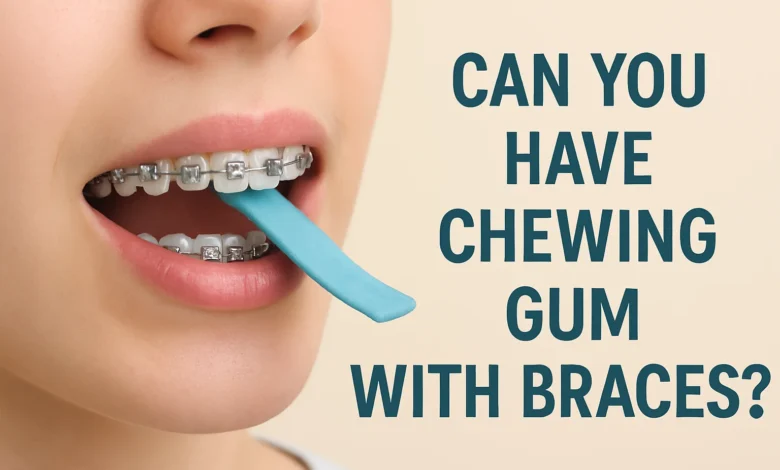
Can You Have Chewing Gum with Braces? What You Need to Know
Introduction
One of the most common questions asked by people with braces is, “Can you have chewing gum with braces?”The major changes braces bring to your daily routine especially regarding food consumption make this concern understandable. People who enjoy sweet foods and use gum for both breath freshness and stress management may find it difficult to stop chewing gum.
This guide provides complete information about chewing gum safety with braces along with associated risks and suitable gum types and all necessary details for maintaining your braces while enjoying chewy snacks. Let’s dive into it!
1. Can You Have Chewing Gum with Braces? Quick Answer
The short answer is no, you shouldn’t chew gum with braces—at least not without significant caution.
Regular chewing gum, particularly the sweet and sticky varieties, can be extremely detrimental to your braces. Chewing gum can result in damage to braces, fractured wires, or the collection of food debris between your brackets which makes the removal of such food bits troublesome and can lead to cavities.
On the other hand, sugar-free gum, particularly with xylitol, could be helpful if you have braces and must chew gum, provided one observes some safety rules.
2. Why Chewing Gum Can Be Problematic with Braces
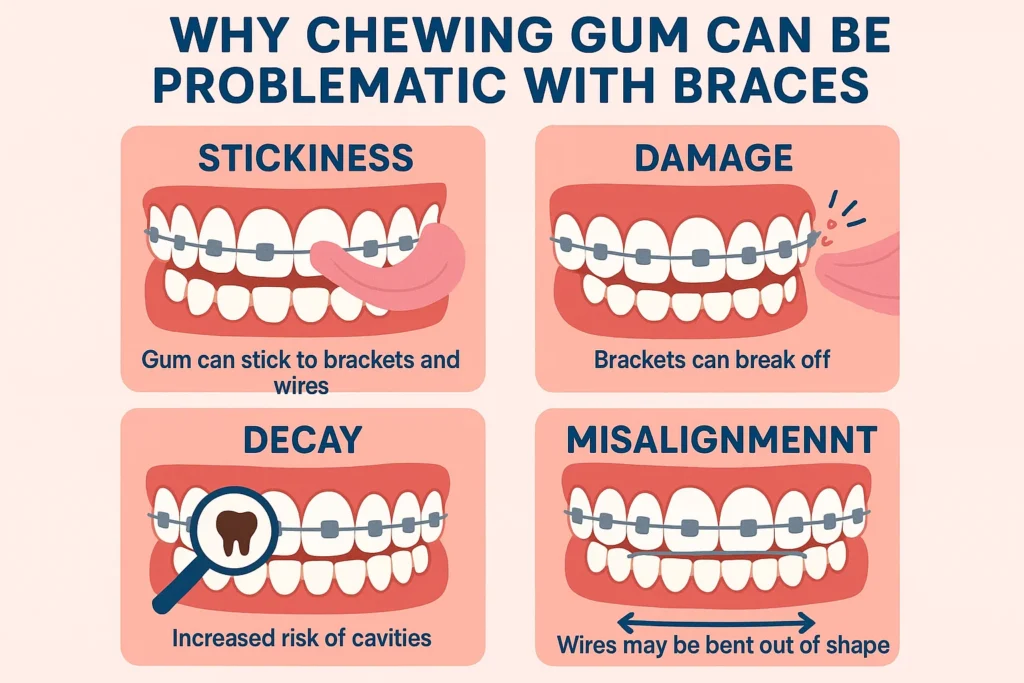
Chewing gum with braces can cause several issues that can disrupt your orthodontic treatment.
1. Bracket Injury:
The way braces operates is by slowly shifting your teeth into the correct position. If you chew overly tough with sticky or overly tough gum, too much strain can be placed on the brackets which may risk the braces breaking or becoming loose.
2. Wire Injury:
When consuming gum, you put pressure on the wires of your braces. That can lead you to have bend wires that are in need of adjustment by the orthodontist. In some situations, the wires can even unseat from the brackets.
3. Sticky Residue:
The sticky nature of chewing gum allows it to easily trap itself around your orthodontic brackets and wires. The sticky nature of chewing gum creates difficulties in cleaning braces while simultaneously raising the risk of plaque accumulation that leads to tooth decay and gum disease.
4. Increased Risk of Tooth Decay:
The sugar content in your chewing gum creates a sticky substance which adheres to your teeth and braces thus providing bacteria with food to produce plaque and cavities. The presence of food particles between the brackets and wires of braces makes it challenging for people to maintain proper oral hygiene.
3. What Happens if You Chew Gum with Braces?
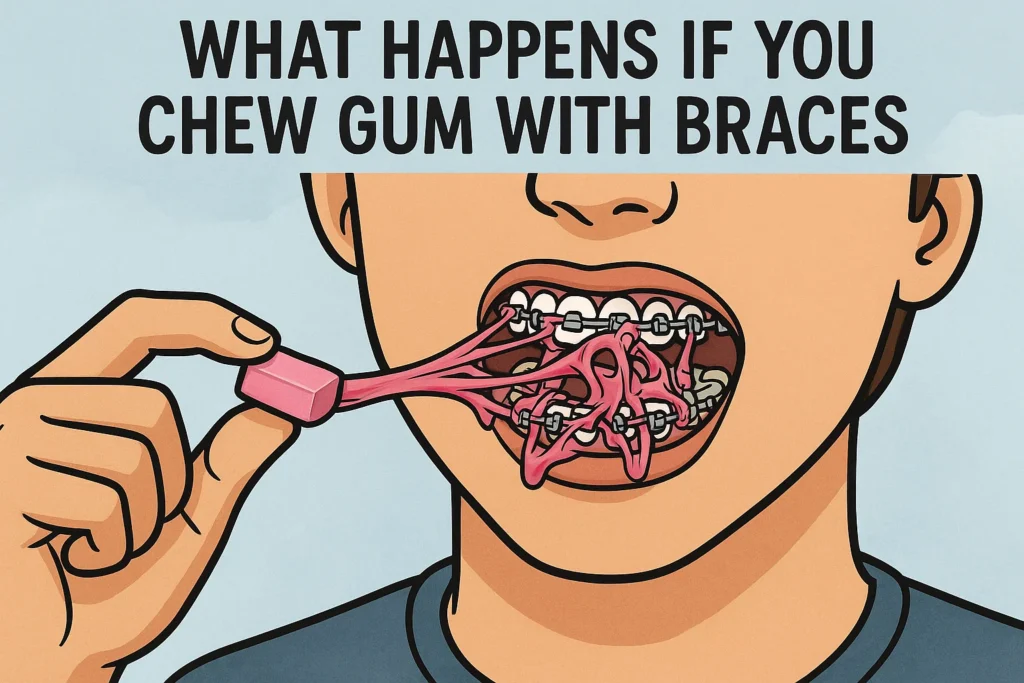
If you choose to chew gum with braces, here’s what might happen:
Bracket damage: The practice of chewing tough or sticky gum poses a risk to dislodge your brackets from your teeth which could extend the duration of your treatment.
Wire breakage or bending:Incorrectly placed braces may malfunction and increase the duration of the treatment due to malfunction and increase the duration of treatment, for example, with the wires may be able to be damaged through tightly chewing gum.
Food stuck in braces:The residue from chewing gum may become trapped in the interproximal spaces of your teeth and dental brackets, making oral hygiene increasingly difficult and possibly lead to dental caries.
Jaw pain:Excessive chewing gum poses the risk of causing strain or discomfort to the patient’s temporomandibular joint due to the persistent exertion of chewing pressure, particularly during the orthodontic adjustment phase of brace treatment.
In short, if you chew gum with braces, you’re risking extra visits to the orthodontist for repairs, longer treatment times, and damage to your teeth.
4. Orthodontists’ Recommendations on Gum and Braces
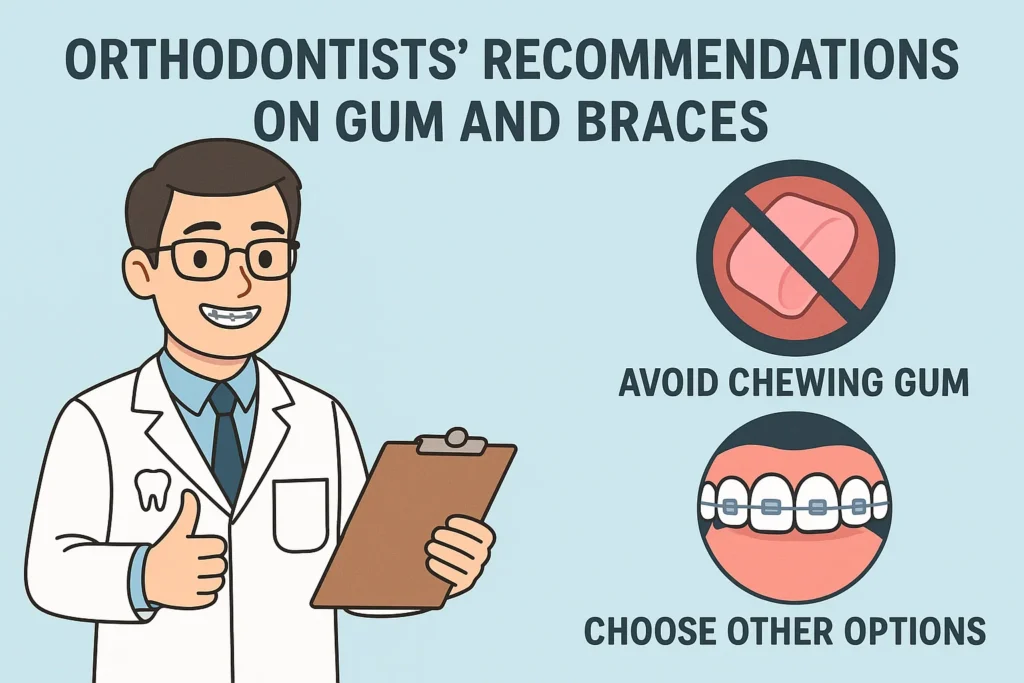
Most orthodontists recommend avoiding gum altogether, especially in the first few months of wearing braces, as your teeth and brackets are still adjusting. Even when it comes to sugar-free gum, many orthodontists prefer that patients err on the side of caution.
Here’s what Dr. Linda Rose, a leading orthodontist in Los Angeles, says:
“Chewing gum can cause significant problems for braces patients. Although sugar-free gum may seem safe, it can still get stuck in the wires and brackets, which makes cleaning a challenge. We advise patients to avoid gum unless it’s absolutely necessary.”
Chewing sugar-free gum containing xylitol is arguably better and more convenient for xylitol sugar-free chewing gum containing xylitol better sugar-free xylitol chewing gum better for sugar-free xylitol containing chewing gum is better, sugar free xylitol gum bearing the Trade Mark stryka is better. Yet, even in this case… …chewing is done gently. The main point is that it is essential that the sugar-free gum does not grip the brackets or exert extra force on the wires.
5. Can You Have Chewing Gum with Braces If It’s Sugar-Free?
While chewing sugar-free gum may seem like a safer alternative, it still poses some risks.
Why Sugar-Free Gum is Better:
No sugar: Gum that’s free of sugar doesn’t contribute to plaque buildup or cavities.
Xylitol: Many sugar-free gums contain xylitol, which has been shown to help reduce the growth of cavity-causing bacteria.
The consumption of sugar-free chewing gum is still contraindicated for individuals with braces as it is likely to affect the brackets and wires entwined with the braces and maintain edentulous regions in the mouth brace-free. Better still, it can impose stress on the braces resulting in discomfort or possible injury. Hence, sugar-free gum, although less problematic than standard gum, still requires restraint.
6. What Happens if Gum Gets Stuck in Your Braces?
Removal of stuck chewing gum in braces is quite a demanding and mildly infuriating task. This is due to the buildup of the sugary and chewy substances in the small brackets and wires of the braces, which would require more meticulous work to remove.
How to Remove Gum from Braces:
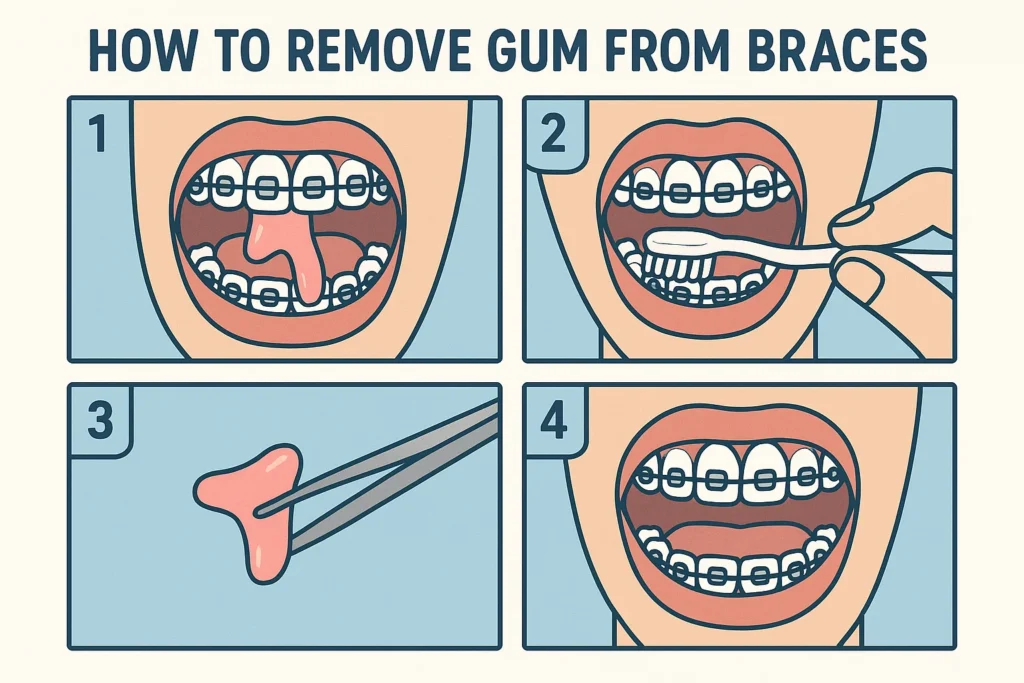
Gently pull off any visible gum: Use your fingers to remove as much gum as possible.
Use a water flosser: A water flosser can help dislodge stuck gum between brackets.
Brush your braces: Use a soft-bristled toothbrush to remove gum residue from your teeth and brackets.
Floss carefully: If gum is stuck between your teeth, floss gently with an orthodontic flosser.
Call your orthodontist: If the gum remains stuck and you’re unable to remove it, contact your orthodontist for advice.
The most effective way to handle gum is to stay away from it but if you do get gum stuck in your braces you should take immediate action to remove it to avoid additional problems.
7. Braces-Friendly Gum: What You Can Chew
While chewing gum with braces is generally discouraged, there are some braces-friendly gums that are less likely to cause damage.
Best Gums to Chew with Braces:
Sugar-free gum (preferably with xylitol) to reduce the risk of cavities
Soft gums that aren’t sticky or chewy
Gums that don’t contain aspartame (for those with allergies or sensitivities)
Examples of safer gums for braces wearers include:
Orbit
Trident
PUR Gum
Spry Xylitol Gum
If you’re going to chew gum, be sure to choose one that is orthodontist-approved and sugar-free to reduce the risks of gum damage.
8. Alternatives to Chewing Gum for Fresh Breath
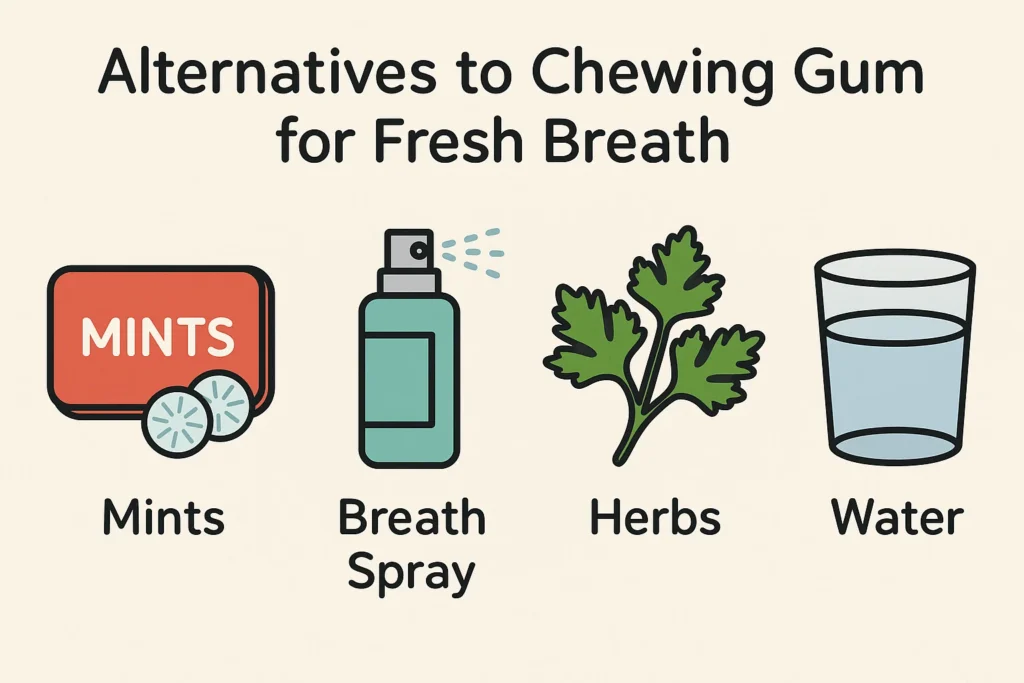
For those fans of gum who enjoy it strictly for its breath-freshening properties, it need not be forsaken in its entirety. There are many substitutes for chewing gum that will not damage your orthodontic wires.
Braces-Friendly Alternatives:
Mints: Opt for sugar-free mints, which are a safer alternative to gum.
Flavored mouthwash: Using mouthwash regularly can help freshen breath and clean your braces.
Sugar-free lozenges: These are a good way to curb your desire for gum without risking damage to your braces.
Chewing on crunchy fruits or vegetables: Apples, carrots, and celery are natural ways to freshen your breath while providing additional health benefits.
9. How to Clean Your Braces After Chewing Gum
Cleaning your braces after chewing gum, whether mistakenly or due to it being lodged in your braces, is very important to prevent plaque accumulation as well as to prevent any potential cavities.
Cleaning Steps:
Rinse with water: First, rinse your mouth with water to loosen any stuck gum.
Brush your teeth: Use a soft-bristled toothbrush to gently clean your teeth, brackets, and wires.
Use an interdental brush: Clean between your brackets and under wires.
Floss with an orthodontic flosser: Make sure to floss thoroughly to remove any remaining gum.
Rinse with mouthwash: Use fluoride mouthwash to eliminate bacteria.
Taking care of your braces will ensure your treatment stays on track, even if you accidentally chew gum.
10. Can You Have Chewing Gum with Braces During Holidays or Events?
Holidays, birthdays, and special events can be filled with tempting foods and candy, including gum. So, can you enjoy chewing gum at these times?
Tips for Special Occasions:
Avoid gum during big meals: Especially when you’re enjoying tougher or chewier foods like steak or candy.
Opt for sugar-free, orthodontist-approved gum: If you must chew, make sure it’s safe for your braces.
Be mindful of chewing habits: Chew in moderation and avoid sticking to gum for long periods.
Always check with your orthodontist before indulging in gum during special occasions, especially if you have concerns about your treatment progress.
11. How to Prevent Gum Damage with Braces
Prevention is the best method for maintaining your braces. Here are some key tips:
Stick to safe foods: Always check for orthodontic-safe foods, especially when out at parties or restaurants.
Follow orthodontist recommendations: Listen to your orthodontist’s advice on eating habits and safe chewing options.
Brush after meals: Keep your braces clean by brushing after every meal, especially after eating foods like gum or candy.
12. Final Thoughts: Can You Have Chewing Gum with Braces?
So, can you have chewing gum with braces?
Generally, the answer is no; during the period of having braces, it’s best not to chew gum and to prevent further complications with the braces. But in the event that you need to chew gum, make sure it is sugar-free, orthodontist approved, and enriched with xylitol, plus chewed in small bites.
An orthodontic treatment is a considerable expense, as well as the care and maintenance during the period you have them. Proper care and maintenance of the braces will yield good results. Remember to follow orthodontic instructions as well as braces-friendly gum policies, and you will have the opportunity to enjoy the comfort that comes with a well-aligned smile.
Color Braces Colors: How to Choose the Perfect Shade for Your Smile



